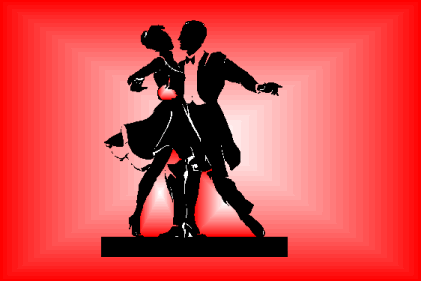Foxtrot
 The Foxtrot (also: "Fox trot",
"foxtrot", "fox trot") is a ballroom dance which takes its name from its
inventor, the vaudeville actor Harry Fox. According to legend, Fox was
unable to find female dancers capable of performing the more difficult
two-step. As a result, he added stagger steps (two trots), creating the
basic Foxtrot rhythm of slow-slow-quick-quick. The dance was premiered
in 1914, quickly catching the eye of the talented husband and wife duo,
Vernon and Irene Castle, who lent the dance its signature grace and
style. It was later standardized by Arthur Murray, in whose version it
began to imitate the positions of American Tango.
The Foxtrot (also: "Fox trot",
"foxtrot", "fox trot") is a ballroom dance which takes its name from its
inventor, the vaudeville actor Harry Fox. According to legend, Fox was
unable to find female dancers capable of performing the more difficult
two-step. As a result, he added stagger steps (two trots), creating the
basic Foxtrot rhythm of slow-slow-quick-quick. The dance was premiered
in 1914, quickly catching the eye of the talented husband and wife duo,
Vernon and Irene Castle, who lent the dance its signature grace and
style. It was later standardized by Arthur Murray, in whose version it
began to imitate the positions of American Tango.
At its inception, the Foxtrot was originally danced to ragtime. Today,
the dance is customarily accompanied by the same big band music to which
swing is also danced.
When rock and roll first emerged in the early 1950s, record companies
were uncertain as to what style of dance would be most applicable to the
music. Famously, Decca Records initially labeled its rock and roll
releases as "Fox trots", most notably "Rock Around the Clock" by Bill
Haley and His Comets. Since that recording, by some estimates, went on
to sell more than 25 million copies, "Rock Around the Clock" is
technically the biggest-selling "Foxtrot" of all time.
 Examples: All Or Nothing at All and Fly
Me To The Moon . Written in 4/4, it can be danced to most
music types, whether slow or fast. If you can walk, you
can dance the Fox Trot! It’s a traveling dance. Hitting
the streets of New York City in the 1920’s, the Fox Trot
emerged as a lively, bouncing dance which America’s youth
went wild over. The Fox Trot was popularized by Harry Fox,
a young vaudeville comedian who incorporated a bouncy, trotting
step nicknamed the Fox Trot.
Examples: All Or Nothing at All and Fly
Me To The Moon . Written in 4/4, it can be danced to most
music types, whether slow or fast. If you can walk, you
can dance the Fox Trot! It’s a traveling dance. Hitting
the streets of New York City in the 1920’s, the Fox Trot
emerged as a lively, bouncing dance which America’s youth
went wild over. The Fox Trot was popularized by Harry Fox,
a young vaudeville comedian who incorporated a bouncy, trotting
step nicknamed the Fox Trot.
The energy of the dance was what teenagers were looking for, and subsequently the only truly American ballroom dance spread like a forest fire across the states.
Today, the Fox Trot has evolved into a dance of social elegance, characterized by smooth, graceful and gliding movements and enjoyed by people of all ages. It remains America’s best loved dance.
This was the dance the Hobart College _Herald_ disgustedly called a "syncopated embrace." And the Cincinnati _Catholic Telegraph_ wrote:
"The music is sensuous, the embracing of partners--the female only half-dressed--is absolutely indecent; and the motions--they are such as may not be described, with any respect for propriety, in a family newspaper. Suffice it to say that there are certain houses appropriate for such dances; but those houses have been closed by law." In the 1920s, this "new style of dancing" was denounced in "family" publications as "impure, polluting, corrupting, debasing, destroying spirituality, increasing carnality," and decent folk were called upon to "raise the spiritual tone of these dreadful young people."